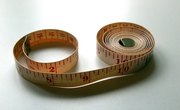
Calculating the area of square or rectangular lots is a simple matter of multiplying the length times the width. A simple shape such as an "L" or a "T" that could be broken into smaller rectangles is slightly more difficult, but the smaller rectangles’ areas are added together.
Calculating the area of a lot with many small sides that do not meet at right angles is not so simple. The area can be calculated with a general equation, however. This equation requires the coordinates (X-Y pairs) of each point along the edge of the polygon.
Obtain X-Y Coordinates
Capture the X-Y coordinates of each point along the lot’s perimeter. Walk the lot line with a GPS unit, pausing at each bend in the lot line to set a waypoint. Make certain that your GPS unit is capturing the UTM coordinates, which are X and Y measurements.
Transfer the coordinates to a text file or to two columns on a spreadsheet. Verify which column is X coordinates (usually 6 digits) and which is Y coordinates (usually 7 digits).
Close the line by repeating the first point in the line at the end of the list.
Hand Method
Begin with the first point in the file. Multiply the X value of this point by the Y value of the next point, and subtract the value of the X value of the next point times the Y value of this point. This is the formula S = (Xi * Yi+1) – (Xi+1 * Yi). Record the result, S.
Move to the next point in the list. Repeat the calculation: multiply the X value of this point times the Y value of the next point, and subtract the product of the X value of the next point multiplied by the Y value of this point. Record the result, S.
Continue moving through the list of points until you have calculated the value of S for the next-to-last point.
Sum all values of S and divide the total by 2. This is A, the area of the lot.
Convert the area of the lot to square feet. Because UTM coordinates are in meters, the value of A is in square meters. To convert square meters to square feet, multiply A by 10.7639104.
Spreadsheet Method
- GPS unit
- Spreadsheet program (optional)
To convert square meters to acres, multiply A by 0.000247105381.
Depending on the accuracy of your GPS unit, you may wish to make several methods at each vertex of the lot and average the coordinates.
List the X coordinates in column A and the Y coordinates in column B.
Type the following formula in cell C1: =(A1_B2)-(A2_B1) and press enter. The spreadsheet automatically calculates the value of S for the first point
Copy the formula in C1 to the bottom of the list, less one row. Doing so calculates the value of S for each vertex of the lot's perimeter.
Sum the list of values in column C and divide by 2. The result is A, the area of the lot.
Convert the area of the lot to square feet. Because UTM coordinates are in meters, A is in square meters. To convert square meters to square feet, multiply A by 10.7639104.
Things You'll Need
Tips
Warnings
References
Tips
- To convert square meters to acres, multiply A by 0.000247105381.
Warnings
- Depending on the accuracy of your GPS unit, you may wish to make several methods at each vertex of the lot and average the coordinates.
About the Author
Kelvin O'Donahue has been writing since 1979, with work published in the "Arizona Geological Society Digest" and "Bulletin of the American Association of Petroleum Geologists," as well as online. O'Donahue holds a Master of Science in geology from the University of Arizona, and has worked in the oil industry since 1982.
Photo Credits
geisha réalisée avec les 7 pièces d'un tangram image by Unclesam from Fotolia.com
